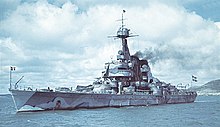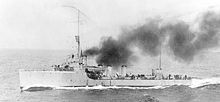Manligheten
|
|
|
|---|---|
 The Manlighetes in their original condition |
|
| Overview | |
| Type | Coastal armored ship |
| Shipyard | |
| Keel laying | . December 1901 |
| Launch | December 1, 1903 |
| Commissioning | December 3, 1904 |
| Decommissioning | February 24, 1950 |
| Technical specifications | |
| displacement |
3650 t, maximum 3735 t |
| length |
89.7 m over everything |
| width |
15.0 m |
| Draft |
5.0 m |
| crew |
275 men |
| drive |
8 Yarrow boilers , |
| speed |
17 kn |
| Armament |
2 × 210 mm Bofors cannons |
| Coal supply |
370 t |
| Armor |
System Krupp |
| Belt Armor Heavy Towers Barbette Light Towers Barbetten Deck |
175 mm |
The Manligheten , put into service in 1904, was the eleventh (coastal) ironclad (Swedish Pansarskepp) in the Swedish fleet . The Manligheten was the fourth ship of the Äran class and, after the sister ship Tapperheten, the second coastal armored ship built by the Kockums company in Malmö . The Äran class also included the Äran built by the Lindholmen shipyard in Gothenburg and the Wasa built near Bergsund in Stockholm . The ships were a further development of the Dristigheten , had the same armament, even if the central artillery was set up in individual turrets, but modern armor. Manligheten was launched in 1933, like two sister ships before. In 1939 she was back in service with the Gothenburg Squadron to ensure Swedish neutrality. From autumn 1940 the outdated and in a bad condition ship was completely modernized. It received a completely new foredeck with a cruciform bow, its superstructures largely rebuilt and relocated to the rear, and all weapons modernized. The boiler system was also completely renewed.
In February 1950 the Manligheten was decommissioned.
Building history
The Manligheten was commissioned as the fourth ship of the Äran class when the three other ships were already in their final stages. The award of the contract was also a reaction to the award of the construction of modern coastal armored ships for Norway in England and the increasing tensions within the union of the two states.
The Manligheten had - like the sister ships - a modern Krupp armor and as the main armament of two 210-mm L / 44- Bofors -Schnellfeuergeschütze Model 98 in individual towers in hswms dristigheten had been introduced and with which the Svea class was retrofitted. Like the sister ships, she had - in contrast to the casemate setup on the Dristigheten - six single turrets with 152 mm L / 44 Bofors rapid-fire guns, model 98, as they were also made for the conversion of the Svea class. For light weapons, ten 57 mm L / 55 Finspång rapid-fire guns, model 89B, were installed as on the previous ironclad ships. The torpedo armament with two 450 mm wide side tubes model 99 corresponded to the predecessor ship Dristigheten .
In 1906 the Manligheten was the first ship of the class to have a tripod mast and modern range finders. At the end of the 1920s, the Manligheten was experimentally equipped with two oil-fired boilers that were supposed to use oil obtained from local deposits.
Shortly after the outbreak of the war in Europe, the old 57 mm anti-torpedo boat guns were removed and replaced by anti-aircraft armament consisting of four anti-aircraft armaments of the old 57 mm L / 55 guns and two 25 mm L / 58 Bofors automatic cannons model 32. The torpedo system was also expanded.
From autumn 1940 the Manligheten on the Götaverken was completely modernized because it was in a poor state of preservation. She received a completely new foredeck with a cruiser bow, her superstructures were renewed and relocated to the rear and all weapons were modernized. After the renovation, the length of the ship was 90.2 m in the waterline and 91.4 m above all. The 57 mm anti-aircraft guns were removed and replaced by four modern 40 mm L / 56 Bofors automatic anti-aircraft guns, model 32, and another pair of the 25 mm Bofors automatic cannons were on board. The heavy and medium artillery received new guns of an improved variant of the previous guns (210 mm Bofors M / 98-36 and 152 mm Bofors M / 98-36), which could achieve better results through higher locations and improved ammunition. The boiler system with six coal and two oil boilers was also completely renewed.
After the Manligheten, mostly known as “Emma” because of the commonly used abbreviation “Ma” , was deleted from the fleet list on February 24, 1950, it was sold for demolition in Karlskrona in 1952. Her hull was converted into a pontoon, which is still in place in Lahälla today.
Mission history
The Manligheten entered service on December 3, 1904 as the last ironclad in the Swedish Navy during the union with Norway . The navy now had four ships with contemporary armor.
The Manligheten made their first trip abroad in 1920 to Amsterdam . In May and June 1926 she visited Amsterdam again with her sister ship Tapperheten , as well as Portsmouth , Guernsey and Vlaardingen . In 1927 the two ships made another trip together to Plymouth , San Sebastián , Bilbao and Rotterdam . After these trips, the Manligheten was experimentally provided with two oil-fired boilers that were supposed to use oil obtained from local deposits.
On August 24, 1930, the Manligheten ran up on the way from Stockholm to the Horsfjärden naval base in poor visibility. The nearby mine cruiser Clas Fleming immediately tried to tow the ironclad back free, but proved to be too weak. Attempts by the armored ship Drottning Victoria also failed, although the Manligheten had given 225 t of coal and unneeded water off board. The demolition of the coastal armored ship was only successful when the destroyer Wachtmeister passed the damaged ship at 24 knots and the swell generated set the Manlighetes in motion.
After Wasa in 1924 and Tapperheten in 1927, the Manligheten was also launched in 1933 , as the Swedish Navy had to reduce the number of its units in service for economic reasons. The upcoming major overhaul of the cadet training ship Oscar II led to the Manligheten taking over this task in 1937 and carrying out a training trip from May to July to Amsterdam, Newcastle , Rouen , Cardiff , Oban , Trondheim and Klaipėda . The Manligheten remained a port ship until the outbreak of war in Europe and was put back into service on August 26, 1939 and assigned to the squadron in Gothenburg as the flagship in September. The squadron consisted of the 498-t destroyers Wrangel and Wachtmeister , the 386-t submarines Hajen , Sälen and Valrossen, and the 345-t mine sweepers Styrbjörn and Starkodder (the former Norwegian whalers Klo and Graham ).
The use as a training ship in 1937 had shown that the ship was in poor condition. The armament in particular was out of date, as the 210 mm guns only had an effective firing range of 11,000 meters and the 150 mm guns only 9,000 meters, while the German light cruisers were able to use their 15 cm guns to fight a battle over 20,000 meters. On December 13, 1939, six men died on board the Manligheten when a German mine floating in front of Gothenburg was to be cleared. Another 14 men were injured. During Operation Weser Exercise , the Manligheten moved on April 8, 1940 with the Göteborg Squadron according to the mobilization plans to Kalvsund , the base of operations for the occurrence of a threatening situation.
At the end of 1940 and in 1941, the above-mentioned modernization took place in Gothenburg, which gave the old coastal armored ship a considerably more modern appearance and again a certain combat value. She remained the flagship of the Gothenburg squadron, which had since been reinforced. In 1940 it still received the former Italian 970-t destroyers Psilander and Puke of the Sella class , in 1944 the 992-t destroyer Klas Horn , and the Karlskrona and Göteborg of over 1000 t, of which Klas Horn and Göteborg as early as 1939/1940 had served there from time to time. The heavily rebuilt old armored cruiser Fylgia and other submarines were also used there. In the spring of 1945, the former torpedo cruiser Jacob Bagge , an even older warship than the Manligheten, also belonged to the Gothenburg squadron.
On February 24, 1950, the Manligheten, usually called "Emma", was deleted from the fleet list and sold for demolition in 1952.
The Swedish coastal armored ships
| Surname | Launch | displacement | length | speed | Main armament |
|---|---|---|---|---|---|
| 3 Svea class | 1885-1893 | 3100-3300 tons | 77.6-82.0 m | 15-16 kn | 1–2 × 254 mm, 4 × 152 mm guns |
| 3 Oden class | 1896-1898 | 3300-3400 tons | 86.3 m | 16.5–17 kn | 2 × 254 mm, 6 × 120 mm guns |
| Dristigheten | 1900 | 3550 t | 89.0 m | 16.5 kn | 2 × 210 mm, 6 × 152 mm guns |
| 4 aran class | 1901-1903 | 3650 t | 89.7 m | 17 kn | 2 × 210 mm, 6 × 152 mm guns |
| Oscar II | 1905 | 4270 t | 95.6 m | 16.5 kn | 2 × 210 mm, 4–2 × 152 mm guns |
| 3 Sverige class | 1915-1918 | 6850-7125 tons | 120.0-121.6 m | 22.5 kn | 2–2 × 280 mm, 1–2 × + 6-152 mm guns |
The Äran- class coastal armored vehicles
| Surname | Shipyard | Launch | In service from | Final fate |
|---|---|---|---|---|
| Wasa | Bergsund , Stockholm | May 29, 1901 | December 6, 1902 | March 1940 deleted |
| Era | Lindholmen shipyard , Gothenburg | August 14, 1901 | September 7, 1902 | June 1947 deleted |
| Tapperhets | Kockums , Malmo | November 7, 1901 | . April 1903 | June 1947 deleted, |
| Manligheten | Kockums, Malmo | December 1, 1903 | December 3, 1904 | February 1950 deleted, |
literature
- B. Weyer: Taschenbuch der Kriegsflotten. JF Lehmanns Verlag, Munich 1905.
- Alexander Bredt (Hrsg.): Weyer's pocket book of the war fleets. JF Lehmanns Verlag, Munich, 35th year 1941.
Web links
- The Äran class
- Side elevation of the era
- The Manlighetes after their completion
- The Manlighetes in Rouen in 1938
- The Manlighetes in Oban in 1938
- The converted Manligheten in 1946
- Långresor och utlandsbesök med svenska örlogsfartyg mellan 1837–2005 (Swedish)
Footnotes
- ↑ Weyer 1905, p. 92f.
- ↑ 25 mm Bofors automatic cannon ( Memento from March 4, 2016 in the Internet Archive )




